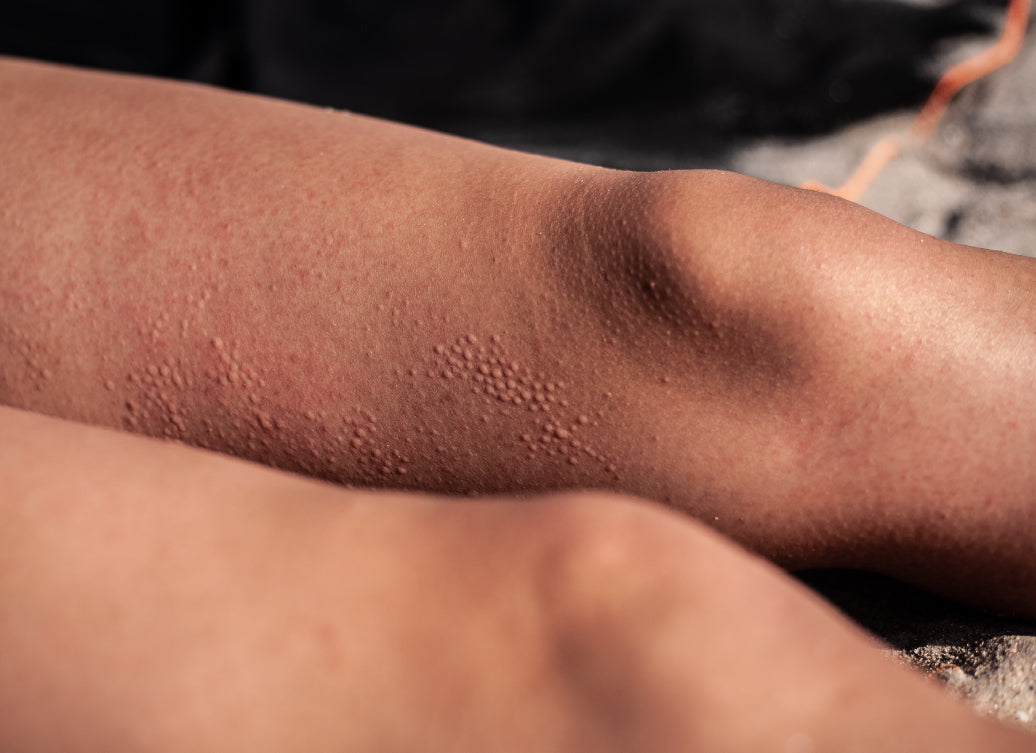Polymorphic light eruption (aka PMLE) is a bit of a mysterious condition, in that there’s no conclusive explanation for why some people are more susceptible than others, and even why it happens at all. It manifests differently in different people, and can come on very suddenly and unexpectedly for the first time later in life, so making any definite statements about the condition isn’t easy!
And that applies to how long it lasts as well. In some ways, the easiest answer is ‘how long is a piece of string?’ but of course the long answer is a bit more complicated. There are things you can do to limit the risk of flare-up, and strategies you can implement to manage the condition.
Let’s look first at what PMLE actually is!
Who gets polymorphic light eruption?
PMLE mainly (but not exclusively) occurs in people, often women, of Caucasian heritage who live in regions where they don’t get much sun during the winter, and whose exposed skin reacts dramatically to bright sunlight. But it can also affect people of colour, and those who live in warmer climates all year round.
What does polymorphic light eruption look like?
It’s characterised by rashes: bumps, hives, spots and plaques, and sometimes even blisters on inflamed skin. PMLE can feel intensely itchy, sore or burning, but the way it looks and feels can be very different in different people.
What happens?
Usually triggered by getting sunlight on newly exposed skin of the arms, legs or upper chest, a first incidence of PMLE can come on suddenly, with a rash appearing within an hour of exposure.
Usually, the rash will resolve itself, though how long this takes depends on various things.
Different experiences of PMLE:
Some people are affected by as little of 30 minutes of sun exposure, while others only react after several hours of sunshine on their skin.
Most PMLE rashes calm down within two weeks of an initial flare, though some recur, and the rash can persist for much longer if the skin is exposed to sunlight again.
Some sufferers only experience a few flares at the beginning of summer and then find that their skin becomes resistant to the effects of the UV light, and are hardened to it within a few weeks.
It often occurs for the first time in your twenties, thirties or forties, but once you've had a first flare of PMLE, it’s likely to recur in subsequent years.
Some people find they get rashes all through the summer, which calm down as autumn takes hold, while others are affected by any sunlight, at any time, even in the winter.
The sad fact is that some people are just more prone to PMLE, and will continue to suffer flares whenever they go out in the sunshine.
What can affect how long PMLE lasts?
- Avoiding the sun: further exposure can prolong the flare, making it last for days or even weeks
- Using sunscreen or protective clothing whenever the sun is out
- Using antihistamines or corticosteroids to reduce inflammation
- Building up resistance with deliberate, gradual, brief sun exposure from spring onwards
- Undergoing desensitisation phototherapy in spring can help severe cases
For more information about polymorphic light eruption, see our article How Is Polymorphic Light Eruption Treated?
You might find Balmonds emollients useful to help keep your itchy skin in good, healthy, resilient condition. Although creams and balms cannot ‘cure’ or treat the root cause of PMLE (or other chronic skin conditions), they are effective at providing hydration, locking in moisture, smoothing thickened areas, and keeping skin soft and supple.
Our products do not contain sunscreens! Do not apply oils or oil-based balms like Skin Salvation to exposed areas of skin in bright sunlight, as the oils can make the skin more likely to burn.
Recommended products:
Balmonds Skin Salvation
with hemp and beeswax
Balmonds Cooling Cream
with shea, menthol, aloe vera & lavender
Balmonds Daily Moisturising Cream
with shea butter and calendula
